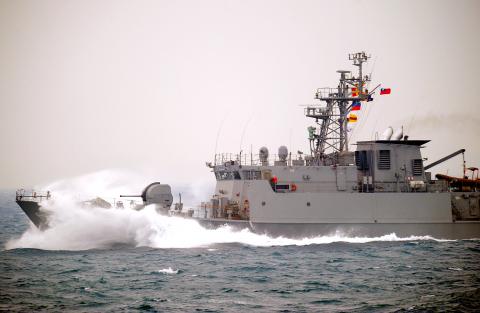The military has begun modifying its fleet of domestically made Ching Chiang-class patrol boats by equipping them with Hsiung Feng III (HF-3) ramjet-powered supersonic anti-ship missiles to counter large surface ships in the Taiwan Strait.
Developed by China Shipbuilding Corp — now known as CSBC Corp, Taiwan — in the 1990s, a total of 11 of the 500 tonne coastal patrol vessels entered service with the navy in 1999 and 2000. The ships were initially equipped with four HF-1 surface-to-surface missiles, one 40mm anti-aircraft gun and one 20mm gun.
In May last year, the Ministry of National Defense unveiled plans to outfit the navy’s eight Cheng Kung-class frigates and a number of Ching Chiang-class vessels with the HF-3, Taiwan’s “aircraft carrier killer” cruise missile developed by the Chungshan Institute of Science and Technology.

Photo: Chang Chung-yi, Taipei Times
Reports yesterday said modification work had begun on seven of the patrol boats, each of which is to be equipped with four HF-3 launchers, and that five Cheng Kung-class frigates had been outfitted with the missile so far as part of a NT$12 billion (US$406 million) program to arm the navy with 120 HF-3s.
A new 500 tonne radar-evasive fast attack corvette, currently at development stage under a project codenamed “Hsun Hai,” or “Swift Sea,” is also expected to be outfitted with eight HF-3s and HF-2s.
Light missile boats like the Ching Chiang, Hsun Hai and the 170 tonne Kuang Hua VI-class vessels launched in recent years are part of ongoing efforts to create an asymmetrical capability to counter China’s increasingly powerful navy. Relatively slow destroyers and frigates with heavy displacement, including aircraft carriers, are seen as particularly vulnerable to asymmetrical strategies.
Although ministry sources have confirmed plans to deploy land-based HF-3s on the west and east coasts of Taiwan, the ministry denied reports last month that an extended range variant of the missile, currently at 300km, was under development.
A longer-range HF-3 would allow Taiwan to deploy the missiles on the eastern coast and aim them at the Taiwan Strait while using mountainous geography, such as that found in Hualien, as cover from missile attacks by China, thus limiting exposure of the launchers.
The HF-3 entered production in 2010. At least 250 are believed to be in service.

Trips for more than 100,000 international and domestic air travelers could be disrupted as China launches a military exercise around Taiwan today, Taiwan’s Civil Aviation Administration (CAA) said yesterday. The exercise could affect nearly 900 flights scheduled to enter the Taipei Flight Information Region (FIR) during the exercise window, it added. A notice issued by the Chinese Civil Aviation Administration showed there would be seven temporary zones around the Taiwan Strait which would be used for live-fire exercises, lasting from 8am to 6pm today. All aircraft are prohibited from entering during exercise, it says. Taipei FIR has 14 international air routes and

Taiwan lacks effective and cost-efficient armaments to intercept rockets, making the planned “T-Dome” interception system necessary, two experts said on Tuesday. The concerns were raised after China’s military fired two waves of rockets during live-fire drills around Taiwan on Tuesday, part of two-day exercises code-named “Justice Mission 2025.” The first wave involved 17 rockets launched at 9am from Pingtan in China’s Fujian Province, according to Lieutenant General Hsieh Jih-sheng (謝日升) of the Office of the Deputy Chief of the General Staff for Intelligence at the Ministry of National Defense. Those rockets landed 70 nautical miles (129.6km) northeast of Keelung without flying over Taiwan,

City buses in Taipei and New Taipei City, as well as the Taipei MRT, would on Saturday begin accepting QR code payments from five electronic payment providers, the Taipei Department of Transportation said yesterday. The new option would allow passengers to use the “transportation QR code” feature from EasyWallet, iPass Money, iCash Pay, Jkopay or PXPay Plus. Passengers should open their preferred electronic payment app, select the “transportation code” — not the regular payment code — unlock it, and scan the code at ticket readers or gates, General Planning Division Director-General Liu Kuo-chu (劉國著) said. People should move through the

The Ministry of National Defense (MND) today released images of the military tracking China’s People's Liberation Army (PLA) movements during the latest round of Chinese drills around Taiwan. The PLA began "Justice Mission 2025" drills today, carrying out live-fire drills, simulated strikes on land and maritime targets, and exercises to blockade the nation's main ports. The exercises are to continue tomorrow, with the PLA announcing sea and air space restrictions for five zones around Taiwan for 10 hours starting from 8:30am. The ministry today released images showing a Chinese J-16 fighter jet tracked by a F-16V Block 20 jet and the